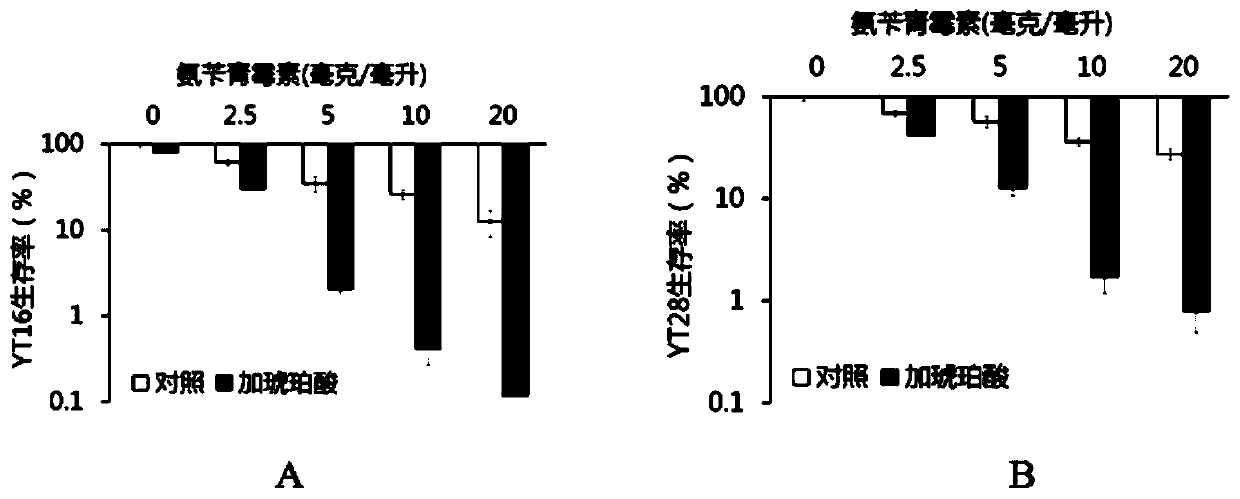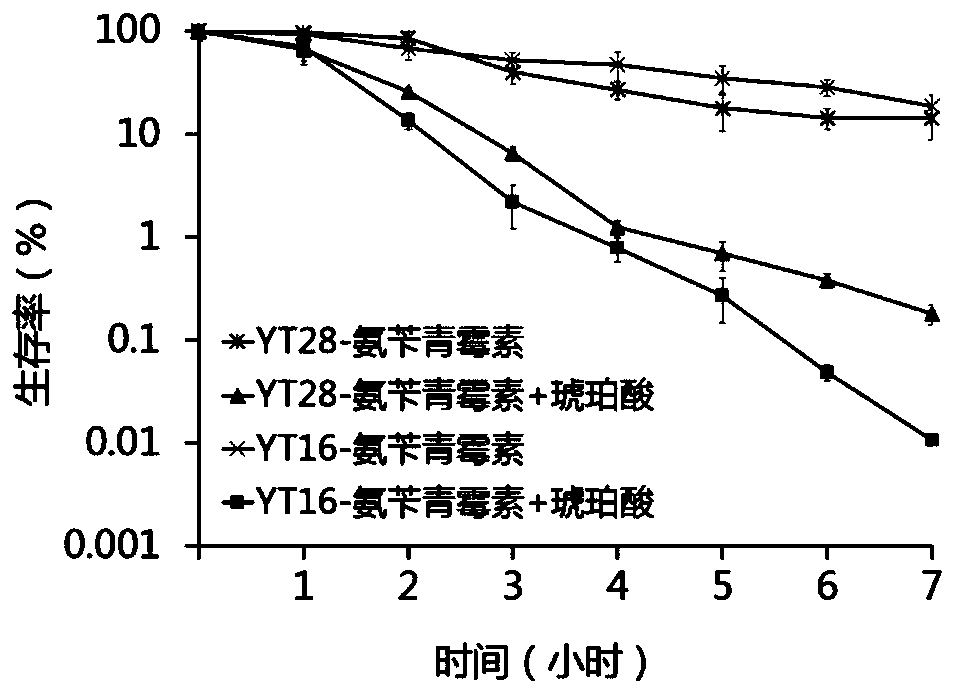The Application of Succinic Acid in Improving the Sensitivity of Bacteria to Antibiotics
A technology of antibiotics and succinic acid, which is applied in the field of medicine to achieve the effect of improving sensitivity, high safety and operability, and improving bactericidal effect
- Summary
- Abstract
- Description
- Claims
- Application Information
AI Technical Summary
Problems solved by technology
Method used
Image
Examples
Embodiment 1
[0044] Embodiment 1 succinic acid improves the sensitivity of clinical Escherichia coli to ampicillin
[0045] 1. Clinical drug resistance analysis of Escherichia coli
[0046] Escherichia coli (Escherichia coli, E.coli) is the most common bacterium in clinical practice. The 30 strains of Escherichia coli obtained from clinical practice were named as YT1-30. According to the NCCLS method, the minimum inhibitory concentration (MIC) of these 30 clinically obtained Escherichia coli to 8 antibiotics was detected, and Escherichia coli K12 was used as a control. The measurement results are shown in Table 1. From the results, it can be seen that the MIC of these 30 strains is more than 4 times higher than that of the control E.coli K12 (except that the MIC of YT1 to ceftazidime is the same as that of the control), that is, the 30 clinical Escherichia coli are all It is a multidrug-resistant bacteria, especially the MIC of ampicillin is 64-4000 times that of the control.
[0047] Tabl...
Embodiment 2
[0069] Example 2 Succinic acid improves the sensitivity of clinical Escherichia coli clinical drug-resistant bacteria to other antibiotics
[0070] 1. Improve sensitivity to penicillin antibiotics
[0071] After adding succinic acid to study whether clinical Escherichia coli has an effect on penicillin antibiotics, prepare two kinds of clinical Escherichia coli samples YT16 and YT28 according to step 2 of Example 1, add 20mM succinic acid and three kinds of penicillins respectively , After 4 hours of action, the number of viable bacteria was counted, and the survival rate was calculated.
[0072] The results showed that succinic acid could improve the sensitivity of clinical Escherichia coli YT16 and YT28 to these three antibiotics. Details are as follows:
[0073] For amoxicillin, after adding 20 mM succinic acid, adding 5 mg / mL amoxicillin can increase the sensitivity of YT16 and YT28 by 15.86 and 13.94 times respectively; adding 7.5 mg / mL amoxicillin can increase the sens...
Embodiment 3
[0079] Embodiment 3 succinic acid improves the sensitivity of various bacteria to ampicillin
[0080] Pick Escherichia coli, Vibrio alginolyticus, Vibrio parahaemolyticus, Edwardsiella tarda, Pseudomonas aeruginosa, Streptococcus beta and other bacterial clones into 100mL LB liquid medium, at 37°C or 30°C, Cultured at 200rpm for 16h to reach saturation. Collect 20 mL of each bacterial liquid, centrifuge at 8000 rpm for 5 min, remove the supernatant and wash the cells with an equal volume of 0.85% saline, and finally suspend the cells with 1×M9 basic liquid medium (containing 10 mM acetate) , adjust the OD value of the bacterial solution to 0.5, and then aliquot 5 mL into test tubes for later use.
[0081] The above-prepared bacterial solution was divided into two groups according to the type of bacteria: the control group (only ampicillin was added) and the experimental group (ampicillin and succinic acid were added). Add 20 mM succinic acid and ampicillin at 2 times the min...
PUM
 Login to View More
Login to View More Abstract
Description
Claims
Application Information
 Login to View More
Login to View More - R&D
- Intellectual Property
- Life Sciences
- Materials
- Tech Scout
- Unparalleled Data Quality
- Higher Quality Content
- 60% Fewer Hallucinations
Browse by: Latest US Patents, China's latest patents, Technical Efficacy Thesaurus, Application Domain, Technology Topic, Popular Technical Reports.
© 2025 PatSnap. All rights reserved.Legal|Privacy policy|Modern Slavery Act Transparency Statement|Sitemap|About US| Contact US: help@patsnap.com



